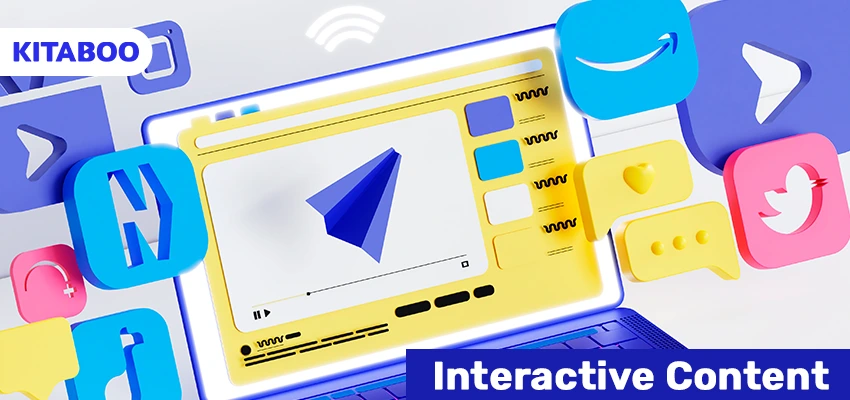
Interactive Content Creation: Tools and Techniques
Summarize this blog with your favorite AI:
The dynamics of content creation, including the higher education department, have undergone a transformative change, moving from static consumption to active user engagement. The emergence of interactive content has become vital in transforming the way academic audiences interact with information.
Encouraging active participation, interactive content not only enhances the overall user experience but also provides invaluable insights for content refinement and, ultimately, contributes to increased engagement.
In this blog, we will delve into the essence of interactive content, exploring its types, tools, and techniques. By understanding the unique needs of the students, the higher education department can effectively create contents that encourage a more engaging and effective learning environment.
Table of Contents
I. What is Interactive Content?
II. Types of Interactive Content You Can Produce?
III. Tools to Create Interactive Content?
IV. Best Interactive Content Creation Techniques
- Strategic Planning for User-Centric Content
- Audience-Centric Matching of Content Types
- Interactive Infographics Design for Engagement
- Enhanced Engagement through Video Content
- Continuous Assessment and User Interaction
V. Conclusion
What is Interactive Content?
Interactive content is a content strategy involving its user’s active participation. It breaks the stereotype of passive consumption and encourages active user engagement.
Interactive content focuses on improving user experience, capturing their attention, and increasing engagement through powerful content. Simultaneously, it provides more feedback from the academic community and enhances the overall learning experience.
Earlier, the content used to be made for passive consumption, but the rise of the internet and social media leads to more engaging content, like blogs and social media posts, where one can share, like, and add feedback to the content.
But this was more inclined towards one-sided interactions, so an upgrade was needed, and that’s where interactive content came into the limelight. Interactive content fills the void of two-sided interaction while giving its consumers a fun and exciting approach.
Types of Interactive Content You Can Produce?
With ample content produced all over the internet, interactive content can keep your content standing out in the vast sea of knowledge.
But the question arises: what type of content is considered interactive content? Interactive content can be readily available, like quizzes, interactive ebooks, or any content that can be converted into interactive content.
Different types of interactive content include quizzes, videos, questionnaires, calculators, resource libraries, lookbooks, and landing pages.
Tools to Create Interactive Content
Creating interactive content drains most of your energy, especially time, but using some tools will help you save both your energy and time, ensuring the content quality remains top-notch.
Here are some tools that you can use to create quality interactive content:
1. KITABOO
KITABOO is a cloud-based digital textbook platform that is a flexible tool for educational publishers. It offers the ability to create interactive content. With its commitment to education and user-friendly interface, KITABOO ensures that your content leaps forward in engagement and effectiveness.
2. Involve.me
Involve.me is a no-code content builder for creating quizzes, surveys, and calculators. It integrates with CRM tools and email marketing services and supports payment integration. It allows customization of customer interactions. It is easy to get started with and provides advanced content creation options.
3. Outgrow
Outgrow provides a variety of interactive content options and facilitates easy integration. It offers over 1,000 pre-optimized templates for quick deployment on webpages, popups, or in chat. It helps in quickly launching interactive content campaigns and provides intelligent analytics for performance assessment.
4. SnapApp
SnapApp is an interactive content platform offering nine interactive content assets, including assessments, quizzes, polls, and more. It integrates with marketing automation, CRM, CMS, and email service providers. It provides a variety of interactive options, allowing users to choose content types that align with their sales approach.
5. Mapme
Mapme is an interactive toolkit for building maps without coding. It allows customization of map styles, markers, and layouts. Maps can be embedded with calls to action for driving conversions. It helps customers find businesses or navigate locations, seamlessly integrating various platforms and supporting different content types.
6. Qzzr
Qzzr is a tool for creating and customizing quizzes. Popular brands use it, and it supports various media types, including text, images, videos, and animations. Its streamlined visual interface makes it easy to create quizzes for your audience, with the flexibility to define specific outcomes.
7. Apester
Apester enables the creation of interactive content experiences that can be shared across multiple channels, saving time and money. It collects zero- and first-party data to fine-tune campaigns. It simplifies content creation and gathers valuable data for optimizing campaigns and improving conversions.
Best Interactive Content Creation Techniques
Interactive content creation is not just a choice but a necessity. While leveraging tools can benefit you by saving time and energy, specific techniques are required to create the best interactive content for your audience. Here are some listed below:
1. Strategic Planning for User-Centric Content
In preparing your approach to strategic planning for user-centric content, laying the foundation with a comprehensive strategy before creating content is essential. Take the time to clearly define the benefits you want users to gain from the interactive experience.
Establish a consistent social media posting schedule for maintaining engagement. Align your chosen content types with strategic goals and user-centric benefits to ensure an effective content development process.
2. Audience-Centric Matching of Content Types
When it comes to audience-centric matching of content types, customize your content to align seamlessly with the preferences of your target audience.
Choose infographics to deliver quick, visually appealing information and leverage videos for engaging mobile-friendly experiences. Conduct polls and surveys to provide valuable insights into audience preferences while featuring user-generated content, promoting trust, and encouraging engagement.
3. Interactive Infographics Design for Engagement
For interactive infographics design, focus on creating visuals that captivate and prompt user interaction and increase engagement.
Utilize design tools to create engaging elements within your infographics, effectively communicating complex information through visually compelling graphics. Ensure your infographics prompt a response or action from your audience, allowing you to showcase your journeys through interactive and visually appealing graphics.
4. Enhanced Engagement through Video Content
It involves the development of videos optimized for mobile users, considering their preferences. Experimenting with diverse video content, such as tutorials or interactive elements, is essential. The strategy also includes:
- Creating compelling and shareable video content.
- Measuring video performance metrics.
- Refining content strategies to ensure alignment with the brand’s messaging and storytelling for maximum impact.
5. Continuous Assessment and User Interaction
Regular assessments are essential to maintain ongoing user engagement. These assessments should encourage user interaction and action, gathering valuable insights that can be used to refine and customize future interactive content.
Featuring user testimonials or quotes helps establish trust and nurture a sense of community. This continuous process ensures the content remains relevant and resonates with the target audience over time.
The Takeaway
Producing interactive content in today’s digital age is not a mere choice but a necessity. This is because the users are more inclined towards this type of content as it is fun and engaging. People find it exciting and valued when they are involved, which interactive content does. Thus, it goes beyond choice and is in great demand today.
Various tools and techniques are present to meet the needs of these ever-growing demands, ensuring that the time and energy are saved without compromising on the quality. Proper use of these tools and techniques will make progress while maintaining the content’s standards.
KITABOO is a cloud-based digital textbook platform that creates interactive content for small and medium publishers. They will help your content to take a level ahead.
Contact us to know more about it and start a conversation.
Discover how a mobile-first training platform can help your organization.
KITABOO is a cloud-based platform to create, deliver & track mobile-first interactive training content.



